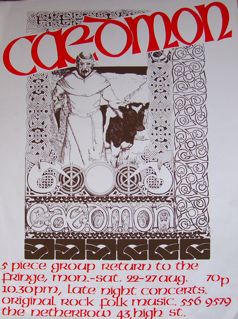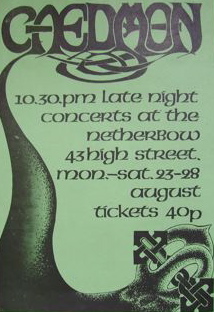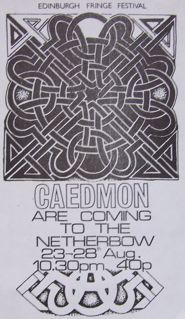| Christmas Term ’73 | ||
|---|---|---|
| 9th Dec | Pollock Carol Service | (Andy, Ken, Angela) |
| Easter Term ’74 | ||
| “Jesus + Folk” – Baird Common Room | Sun Feb 17th | (“CAEDMON” [+ Sam + Simon]) |
| Summer Term ’74 | ||
| “Jesus Thing” George Sq. | May 3rd, Fri | |
| “Jesus Thing” George Sq. | May 10rd, Fri | |
| “Time Machine” | 3rd May 8.00 pm | |
| Summer Vacation4 | ||
| Elm Howe, Patterdale | Sept 25th-28th ’74 | (Simon, Sam, Angie) |
| Andy’s Flat | ||
| Autumn Term ’74 | ||
| Freshers week | Fri & Sat nights | Hill Place |
| Sun night | Baird Common Rm. | |
| Torch Fellowship | October – Sat afternoon | (Jim joined) |
| Time Machine | Nov 8th | |
| Rutherglen – Stonelaw Church (Dennis Brice)[1] | Nov 10th | |
| George Sq bread & cheese lunches | Thursdays | |
| Pollock Carol Service | Sun Dec 8th | |
| Queen Margaret’s College | Dec 11th [or 10th?] | (Carol Service) |
| Charisma | Dec 13th | |
| Spring Term ’75 | ||
| Sellindge Vicarage | Dec 31st – Jan 3rd | |
| Denny High School | Jan 8th 12.30pm + 4pm | |
| Motherwell Maranatha Centre | Jan 12th | |
| Mission Cafe | Jan 16th + Jan 17th | |
| KB Union | Jan 20th 1pm | |
| Mission Cafe | Jan 25th | |
| Radio Forth recording (Netherbow) | Jan 27th | |
| Radio Forth programme | Feb 2nd 7.30am | |
| International reception | Feb 5th | (+ Alan)[2] |
| Queen Margaret College | Feb 10th | |
| ‘Mitre’ audition | Feb 13th | |
| St Thomas’s Guest Service | Feb 16th | |
| Charisma | Feb 21st | |
| ‘Mitre’ | Feb 22nd | |
| Craigmount School | Feb 24th + Feb 28th | |
| Mitre | ||
| Charisma | Mar 7th | |
| Summer Term ’75 | ||
| Fri 11th April | Whitley Bay Baptist Church | (33 C.P.A. NEWCASTLE Wed 9th -> Sun 13th)[3] |
| Thurs 17th | Dunfermline College of Physical Education | |
| Fri 18th | Charisma | |
| Sat 19th | Mitre | |
| Fi 25th | Charisma | |
| Sat 26th | Mitre | |
| Thurs 1st May | East Suffolk Halls | |
| Sat 3rd | Mitre | |
| Fri 9th | Charisma | (with Water Into Wine Band) |
| Sat 10th | Motherwell Civic Theatre | |
| Sun 11th | Bathgate | |
| Fri 16th | Crieff, Morrison’s School | |
| Sat 17th | Mitre | |
| Fri 23rd | Charisma | |
| Sat 24th | Mitre | |
| Sat 31st | Mitre | |
| Fri 6th June | Eyemouth | |
| Sat 7th | Mitre | |
| Fri 13th | Charisma | |
| Summer Vac | ||
| Netherbow | ||
Links to later academic years will appear in the sidebar.
[1] Dennis Brice was a fellow student who, IIRC, had recently become a minister and invited us to his church. He had a green Renault 4, I seem to recall.
[2] Alan Torrance – see reference on another page on this site – I’ll link to it when I work out how.
And in case there are any doubters out there, here’s video evidence that Caedmon can actually still play their instruments. … In 1978, a small christian folk rock band in Edinburgh released a farewell album to celebrate six years of making music together. The album was made on a shoestring budget and only 500 copies were pressed. The musicians went their separate ways. Forty years on, the record remains a collectors item. A new re-release on the Guerssen record label is due and it has been described as one of the best folk rock albums of the seventies. The band started writing again for the 2008 30th anniversary of the album, and produce ‘A Chicken to Hug’ on CD and on-line. And with the 40th anniversary they are producing a new package on vinyl called RARE, a 12″ LP and 7″ single in a sleeve with insert: seven new songs, six from 1975 and a surprise track. So, with all the hype and the misinformation that seems to have followed it, we found ourselves obliged to set the record straight. And what better way than our own web site. CLICK ON ‘WEBLOG’ for current activity, ‘NOW’ for news of new music making, ‘THEN’ for a historical perspective, and ‘LINKS’ to migrate to other related websites. Forty two years have passed. The band has got together to record seven new songs in an album called ‘RARE’. These is teamed with six unheard Caedmon tracks from 1975/78 in a vinyl package reminiscent of their first album: a 12″ LP and a 7″ single. ‘RARE’, title track, reflects upon the story of the ’78 album. Originals command four figure prices in the vinyl collecting world and they have become a grail for Acid Folk collectors. On the 30th anniversary of the break up on the band they reformed meeting for weekends in Weardale, Co. Durham, in the north of England. Caedmon was always a weird mixture of musicians and their musical influences jostling to find some space to work together. With thirty years to establish and cement those disparate styles, what did this bizarre mixture bring to the table? Jim doesn’t use a fuzz box to try and rock out quietly, Ken plays everything including the cello, Simon has dropped the bongos for a full drum kit, Sam now plays a gut throbbing five string bass, and Angela… well Angela, initially reluctant, has been persuaded to get behind a mic again. Now she’s a working vet, and possibly the only member of that student band that actually does what she trained for at university. So how has the music changed in those thirty years? The evidence of their toil is now available on Amazon, iTunes, and eBay in a smart digipak-ed limited edition CD or as download: ‘A Chicken to Hug’ Initial reviews find a connection between the old and new in their music. Also, thankfully, there’s a sense that Caedmon’s music has progressed expressing maturity, variety and novelty. Find out more about the history of the Acid Folk group Caedmon that started in 1973. CLICK ON Kissing Spell followed up their rerelease of the Caedmon 1978 album with live tracks from two concerts in 1977 / 1978. London Psalm is everyone’s favourite on blogs. The tracks are: 1.) London Psalm Sam Wilson, 05 mins 56 secs We recorded a whole bunch of tracks in the Netherbow Arts Centre in 1975?. The Netherbow had a small broadcast studio in the top level, and although it was never really designed for recording bands, it was our first attempt at proper studio recording. Five of these tracks now appear on RARE. The farewell concert was also recorded but never published.
Caedmon’s first public concert, Pollock Halls, Edinburgh University. Andy Love: guitar from Aberdeen All three were veterinary students. Simon Jaquet: mandolin, guitar, clarinet and bongoes from Sellindge Kent (a student of French) Both join the band in early 74. First concert as a 5-piece in Pollock Halls, Baird House common room round about Easter 74. At the end of the summer vacation there is a slightly abortive week’s rehearsal at Elm How, a pink cottage in the Lake District. Andy and Ken can’t make it because of failed resits. Angela, Simon and Sam jam for hours and spend a lot of time walking to the shops which are about 4 miles away. Andy leaves vet school for home in Aberdeen and Ken transfers to Psychology. Late in 74 Jim Bisset, electric guitar, from Crieff, Perthshire joins the band. He’s studying Divinity. Simon’s course takes him to France. Fiddler Alan Torrance plays with Caedmon in his absence. Jim, Ken and Sam move into a flat together along with Jim’s sister. They tour widely in a borrowed Austin Maxi and a Volkswagen Caravette. Alan Stevens (another Vet student) helps with sound. Caedmon appear at the Edinburgh Fringe for a week of late night concerts at The Netherbow Arts Centre on The Royal Mile, with Gordon Strachan (photography), Carolyn Dougill (sound) and George Anderson (lighting). Second year at the Edinburgh Fringe for a week of concerts. At the end of the week they travel overnight in their Ford Transit van ‘Abysilda’ to perform the following afternoon at the Greenbelt Festival in a marquee. Squeezed by programming needs into a meagre slot to accommodate ‘Nutshell’. They record their eponymous LP to celebrate their five years as a band. They spend two weekends in Barclay Towers Studio in a garret in Bruntsfield. Twelve tracks are mixed down. Ken designs sleeve, Sam the sleeve notes, Angela the lyric sheet and a photo is taken on Arthur’s Seat. Twelve tracks proves to be too much for one album so a 45 rpm single is included in the package. 500 copies are made. They are sold at the Farewell Concert in George Square, Edinburgh in the month of March, to friends and fans. Ken and Angela leave Edinburgh.And here’s the video evidence
Caedmon – together again
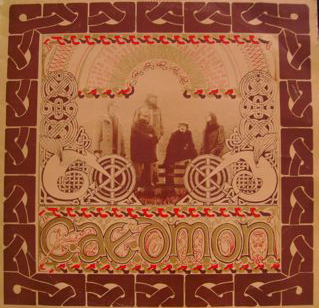
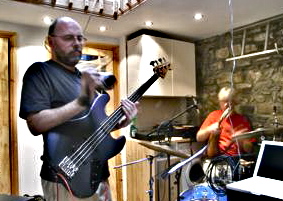
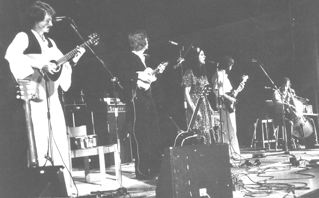
The album, Other recordings, The band, Classifying Caedmon, The facts,
The gigs, ’73 – ’75, ’75 – ’76, ’76 – ’77
The history, 1973 – 1978, 1979 – 2008Breaking News
Caedmon ‘Live’: Kissing Spell
2.) Ivory Tower Jim Bisset, 05 mins 16 secs
3.) Worlds and Friends Ken Patterson, 04 mins 47 secs
4.) Aslan Simon Jaquet 05 mins 13 secs
5.) Sea Song Simon Jaquet 05 mins 48 secs
6.) The Garden Caedmon 07 mins 58 secs
7.) Caedmon Hymn Jim Bisset 04 mins 38 secs
8.) Sunchild Jim Bisset 04 mins 41 secs
9.) Heaven Haven Poem: G.M. Hopkins, Music: Simon Jaquet 02 mins 46 secs
10.) Ten Maidens Fair Ken Patterson 04 mins 19 secs
11.) Maker Man Ken Patterson 03 mins 02 secs
12.) Storm Caedmon 06 mins 19 secs 1978
13.) Beyond the Second Mile Sam Wilson 06 mins 48 secs
14.) Columba Jim Bisset 02 mins 42 secsThe Netherbow Recordings
December 1973
Angela Naylor: vocals from Brighouse, Yorkshire
Ken Patterson: ‘cello, keyboards and guitar from Newcastle upon Tyne 1974
Sam Wilson: guitar and bass guitar from Prestwich, Manchester (a student of Chemical Engineering)1975
1976
They start to play weekly in The Mitre pub on the same street. Tony Welbrock starts to sound mix for the band.1977
1978
